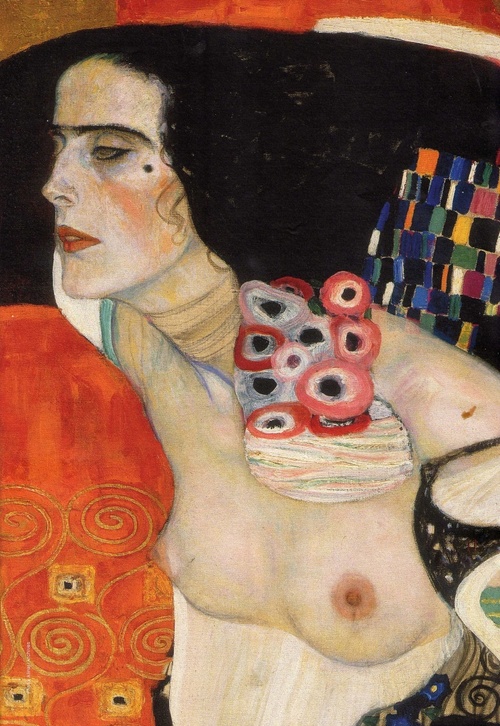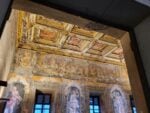Klimt. Alle origini di un mito

La mostra si propone di indagare i rapporti familiari e affettivi di Klimt, esplorando gli inizi della sua carriera alla Scuola di Arti Applicate di Vienna e la sua grande passione per il teatro e la musica attraverso l’esposizione di opere provenienti anche da altri importanti musei, tra cui diversi capolavori come Adamo ed Eva (Adam and Eve), Giuditta II, Girasole (Sonnenblume) e Acqua mossa (Bewegtes Wasser).
Comunicato stampa
La mostra, organizzata dal Comune di Milano, Palazzo Reale, 24 ORE Cultura e Arthemisia Group, realizzata in collaborazione con il Museo Belvedere di Vienna e curata da Alfred Weidinger, affermato studioso di Klimt e vicedirettore del Belvedere, presenta per la prima volta a Milano alcuni dei più noti capolavori provenienti dai più importanti musei.
Proprio il Museo Belvedere, in occasione del 150° anniversario della nascita di Klimt ha organizzato nel 2012 un grande mostra che dava conto della formazione, dello sviluppo e dell’apice della carriera artistica del genio austriaco, riunendo molti lavori di Klimt tra cui 40 oli. Nella mostra milanese, aperta dal 12 marzo al 13 luglio a Palazzo Reale, ve ne saranno 20, oltre ad altri suoi lavori e di artisti a lui vicini, a cominciare dai fratelli Ernst e Georg, per un totale di oltre 100 opere.
La ricostruzione originale del “Fregio di Beethoven” – esposto nel 1902 a Palazzo della Secessione a Vienna, fondata nel 1897 – chiuderà il percorso espositivo, occupando un’intera sala e “immergendo” il visitatore nell’opera d’arte totale, massima aspirazione degli artisti della Secessione viennese e tutto il percorso espositivo si avvarrà di un allestimento che integra tematiche e opere nel contesto di arte totale proprio della movimento.
La mostra si propone dunque di indagare i rapporti familiari e affettivi di Klimt, esplorando gli inizi della sua carriera alla Scuola di Arti Applicate di Vienna e la sua grande passione per il teatro e la musica attraverso l’esposizione di opere provenienti anche da altri importanti musei, tra cui diversi capolavori come Adamo ed Eva (Adam and Eve), Giuditta II, Girasole (Sonnenblume) e Acqua mossa (Bewegtes Wasser).
The exhibition Klimt: The Origins of A Legend, jointly arranged with the Belvedere Museum in Vienna (Österreichische Galerie Belvedere) and promoted by the City Council of Milan-Cultura, has been organized and produced by the Palazzo Reale, 24 ORE Cultura – Gruppo 24 ORE, and the Arthemisia Group. The curator of the exhibition is Alfred Weidinger, the well-respected Klimt scholar and vice-director of the Belvedere, in conjunction with the Klimt scholar Eva di Stefano for Italy.
Twenty oil paintings by Gustav Klimt will be on display at the Palazzo Reale from 12 March to 13 July: an extraordinary number, considering that only 100 paintings and frescoes by the artist are known to us today, and that, on the occasion of the 150th anniversary of Klimt’s birth, the Belvedere Museum exhibited a total of forty oil paintings in its blockbuster 2012 show that traced the brilliant Austrian artist’s career, from his early training and development to his maturity.
The original reconstruction of the Beethoven Frieze – displayed in Vienna in 1902 in the Secession Building built in 1897 – will occupy an entire room of the Palazzo Reale, “immersing” visitors in this total work of art – a concept that was the highest aspiration of the artists that made up the Vienna Secession – to the strains of Beethoven’s Ninth Symphony. Indeed, the exhibition is so arranged as to firmly place themes and artworks in the context of total art, the movement’s hallmark.
The exhibition also takes a thorough look at Klimt’s relationship with his family and his sentimental attachments, examining the start of his career at Vienna’s School of Applied Arts as well as his love of theatre and music. A number of works come from other leading museums; this is the case for masterpieces such as Adam and Eve, Salome, Sunflower and Water in Motion.
Special attention will be paid to Klimt’s youthful output, his training at the Kunstgewerbeschule in Vienna and his first commissions to decorate the monumental buildings that had sprung up along the Ring, following in the footsteps of Hans Makart. This initial phase would prove decisive in steering the artist towards an embrace of modernity, precisely because, as Agnes Husslein-Arco, the director of the Belvedere, explains in the catalogue: “It is a little-known fact that the Künstler-Compagnie, the group of artists founded in 1881 by Gustav Klimt, Franz Matsch (Klimt’s classmate at the School of Applied Arts at the Austrian Museum for Art and Industry), and Klimt’s younger brother Ernst, was active for nearly twelve years and owed much of its reputation to its painted decorations of public buildings, particularly theatres. These commissions can be thanked for the success of this group of painters, especially Gustav Klimt, on Vienna’s art scene.”
Klimt: The Origins of A Legend takes visitors on a journey of discovery, to explore the career of an artist who has become a legend by means of several of the Austrian artist’s best-known masterpieces, which still enchant viewers today. Works on display include: Adam and Eve, The Family, Sunflower, Will O’ the Wisp, Water in Motion, and Salome, not to mention his evocative landscapes After the Rain and Cows in Stall, as well as his superb portraits of women.
The first part of the exhibition places the artist in the context of his family; alongside works by his brothers Ernst and Georg, Klimt’s youthful portraits of his own family members are on display, as well as original photographs from the artist’s bequest.
The second part of the show is devoted to the Klimt brothers’ apprenticeship at the Vienna School of Arts & Crafts, when they co-founded, together with Franz Matsch, the so-called Künstler-Compagnie (Artists’ Company). The paintings featured here illustrate Klimt’s training as a history painter and the influence of Hans Makart’s art on his own development. The entire season of the Künstler-Compagnie is covered, up to the death of Ernst Klimt in 1891. Thanks mainly to large sketches of the brothers’ decorative paintings for theatres and museums, the three artists clearly emerge as Hans Makart’s heirs, while departing from his neo-Baroque style.
Klimt’s creative crisis after the Künstler-Compagnie disbanded is placed in the broader framework of the crisis in Viennese art as a whole, which would lead to the founding of the Secession. A selection of works from its earliest phase attests to Klimt’s definitive rejection of the historical tradition and his consequent embrace of the international avant-garde.
Two rooms will be devoted to portraits and landscapes, genres that interested Klimt from the very founding of the Secession. Three of his finest portraits of women – Lady by the Fireplace and the two Portraits of a Lady – which Klimt painted between 1894 and 1898, provide an in-depth understanding of his forays into the first genre and also illustrate the artist’s special relationship with the female sex. Several recently-discovered love letters that Klimt addressed to Emilie Flöge are also on display, furnishing an intimate glimpse of the artist’s romantic attachments.
The room devoted to landscapes not only features two significant works by Klimt himself – After The Rain and Cows in Stall – it also provides an overview of Austrian landscapes at that time, from the earliest, late-19th-century impressionistic works to the Secession paintings by Carl Moll and Koloman Moser.
Lastly, two more paintings, Will O’ The Wisp and The Family, are emblematic of Klimt’s symbolistic phase, the section that rounds out the exhibition.
The catalogue is published by 24 ORE Cultura.



